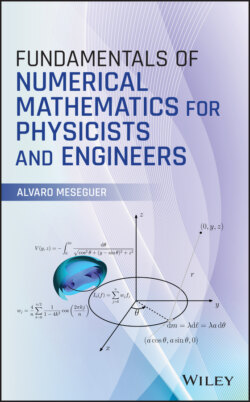Fundamentals of Numerical Mathematics for Physicists and Engineers

Реклама. ООО «ЛитРес», ИНН: 7719571260.
Оглавление
Alvaro Meseguer. Fundamentals of Numerical Mathematics for Physicists and Engineers
Table of Contents
List of Tables
List of Illustrations
Guide
Pages
Fundamentals of Numerical Mathematics for Physicists and Engineers
About the Author
Preface
Acknowledgments
1 Solution Methods for Scalar Nonlinear Equations. 1.1 Nonlinear Equations in Physics
1.2 Approximate Roots: Tolerance
1.2.1 The Bisection Method
1.3 Newton's Method
1.4 Order of a Root‐Finding Method
1.5 Chord and Secant Methods
Practical 1.1 Sliding Particles over Surfaces
1.6 Conditioning
1.7 Local and Global Convergence
Complementary Reading
Practical 1.2 Throwing Balls and Conditioning
Problems and Exercises
Notes
2 Polynomial Interpolation. 2.1 Function Approximation
2.2 Polynomial Interpolation
2.3 Lagrange's Interpolation
2.3.1 Equispaced Grids
Practical 2.1 Lagrange Equispaced Interpolation
2.4 Barycentric Interpolation
Interpolation Forms (Summary)
2.5 Convergence of the Interpolation Method
Result I Weiertrass' Approximation Theorem
Result II Cauchy's Remainder for Interpolation
2.5.1 Runge's Counterexample
2.6 Conditioning of an Interpolation
Practical 2.2 Conditioning of Equispaced Nodes
2.7 Chebyshev's Interpolation
Convergence Rate of Chebyshev's Interpolation
Practical 2.3 Barycentric‐Chebyshev Interpolation
Complementary Reading
Problems and Exercises
Notes
3 Numerical Differentiation
3.1 Introduction
Numerical Differentiation
3.2 Differentiation Matrices
Summary: Differentiation Matrix
3.3 Local Equispaced Differentiation
3.4 Accuracy of Finite Differences
Nodal Error of Interpolatory Differentiation
Practical 3.1 Equispaced (Local) Differentiation
3.5 Chebyshev Differentiation
Reducing (Constant ): Local Differentiation
Reducing the Error by Increasing : Global Differentiation
Chebyshev Differentiation Matrix
Practical 3.2 Local Versus Global Numerical Differentiation
Complementary Reading
Problems and Exercises
Notes
4 Numerical Integration. 4.1 Introduction
4.2 Interpolatory Quadratures
Summary: Interpolatory Quadrature Formulas
4.2.1 Newton–Cotes Quadratures
Closed and Open Newton–Cotes Formulas
4.2.2 Composite Quadrature Rules
4.3 Accuracy of Quadrature Formulas
Error and Degree of Exactness of a Quadrature Formula
Quadrature Errors of Newton–Cotes Formulas
Quadrature Errors of Composite Newton–Cotes Formulas
Practical 4.1 Local Versus Global Equispaced Quadratures
4.4 Clenshaw–Curtis Quadrature
Chebyshev Polynomials
Summary: Clenshaw–Curtis Quadrature
Practical 4.2 Gravitational Potential of a Ring
4.5 Integration of Periodic Functions
Geometrical Convergence of Composite Trapezoidal Rule
4.6 Improper Integrals
4.6.1 Improper Integrals of the First Kind
4.6.2 Improper Integrals of the Second Kind
Practical 4.3 Beads Moving Along Wires
Complementary Reading
Problems and Exercises
Notes
5 Numerical Linear Algebra. 5.1 Introduction
5.2 Direct Linear Solvers
5.2.1 Diagonal and Triangular Systems
5.2.2 The Gaussian Elimination Method
Summary: Gaussian Elimination Method (GEM)
5.3 LU Factorization of a Matrix
Property 1: Product of Lower Triangular Matrices
Property 2: Inverse of a Non‐singular Lower Triangular Matrix
Definition (Dyadic Product of Two Vectors)
Property (Existence and Uniqueness of LU‐Factorization)
5.3.1 Solving Systems with LU
5.3.2 Accuracy of LU
5.4 LU with Partial Pivoting
Definition: Permutation Matrix
Definition: Exchange Matrix
Property: Action of an Exchange Matrix
Practical 5.1 Equivalent Resistance
5.5 The Least Squares Problem
5.5.1 QR Factorization
Orthogonal Matrix
Householder Transformation (Reflector)
Property
Summary (Vector Reduction Using Reflectors)
Theorem (QR‐Factorization)
5.5.2 Linear Data Fitting
Practical 5.2 Least Squares Polynomial Fit
5.6 Matrix Norms and Conditioning
Matrix Norm
Induced Vector or Operator Norm of a Matrix
Condition Number of a Matrix
Accuracy of GEM-LU Solutions with Partial Pivoting
5.7 Gram-Schmidt Orthonormalization
5.7.1 Instability of CGS: Reorthogonalization
Practical 5.3 Gram–Schmidt and Reorthogonalization
5.8 Matrix‐Free Krylov Solvers
Krylov24 Spaces and Krylov Matrices
Practical 5.4 Matrix‐Free Krylov Solvers (GMRES)
Complementary Reading
Problems and Exercises
Notes
6 Systems of Nonlinear Equations
6.1 Newton's Method for Nonlinear Systems
Newton's Iteration for Nonlinear Systems
Quadratic Convergence (Newton–Kantorovich Conditions)
Practical 6.1 Newton's Method in
6.2 Nonlinear Systems with Parameters
6.3 Numerical Continuation (Homotopy)
Practical 6.2 Numerical Continuation
Complementary Reading
Problems and Exercises
Notes
7 Numerical Fourier Analysis
7.1 The Discrete Fourier Transform
Summary: DFT and IDFT
7.1.1 Time–Frequency Windows
Summary: Frequency Window
7.1.2 Aliasing
Practical 7.1 Discrete Fourier Transform (DFT)
7.2 Fourier Differentiation
Summary: Fourier Differentiation
Complementary Reading
Problems and Exercises
Notes
8 Ordinary Differential Equations
8.1 Boundary Value Problems
8.1.1 Bounded Domains
BVP (Bounded Domain)
Practical 8.1 The Suspended Chain
8.1.2 Periodic Domains
8.1.3 Unbounded Domains
8.2 The Initial Value Problem
8.2.1 Runge–Kutta One‐Step Formulas
8.2.2 Linear Multistep Formulas
Linear Multistep Formulas (LMSF)
Practical 8.2 Gravitational Motion
8.2.3 Convergence of Time‐Steppers
Order of Convergence of One‐Step Methods
Order of Convergence of an ‐step LMSF
Order of Convergence of Explicit Runge–Kutta Methods
Order of Convergence of Explicit AB and Implicit BDF Formulas
8.2.4 A‐Stability
Absolute Stability of a Time‐Stepper
Characteristic Polynomials Associated with an LMSF
Homogeneous Linear Difference Equations
A‐Stability
8.2.5 A‐Stability in Nonlinear Systems: Stiffness
Absolute Stability of a Time‐Stepper: Linear Systems
Linearized Criterion for Stability
Stiffness
Practical 8.3 Shock Waves (Method of Lines)
Complementary Reading
Problems and Exercises
Notes
1 Solutions to Problems and Exercises. Chapter 1
Practical 1.1
Practical 1.2
Chapter 2
Practical 2.3
Chapter 3
Practical 3.1
Practical 3.2
Chapter 4
Practical 4.1
Practical 4.2
Practical 4.3
Chapter 5
Practical 5.1
Practical 5.2
Practical 5.3
Practical 5.4
Chapter 6
Practical 6.1
Practical 6.2
Chapter 7
Practical 7.1
Chapter 8
Practical 8.1
Practical 8.2
Practical 8.3
Glossary of Mathematical Symbols
Bibliography
Index
WILEY END USER LICENSE AGREEMENT
Отрывок из книги
Alvaro Meseguer
Department of PhysicsUniversitat Polit`ecnica de Catalunya – UPC BarcelonaTech
.....
Expression (1.13) is less formal but certainly provides more insight. For example, in the linear case (1.13) implies that , since for . In other words, the sequence must be monotonically decreasing in order to have linear convergence. According to Table 1.1, , and therefore the bisection method does not qualify to have linear convergence in the sense of (1.11)10
We can numerically estimate the actual order of convergence by taking the logarithm of both sides of (1.13) and setting the quantities , , and , so that the expression now reads
.....